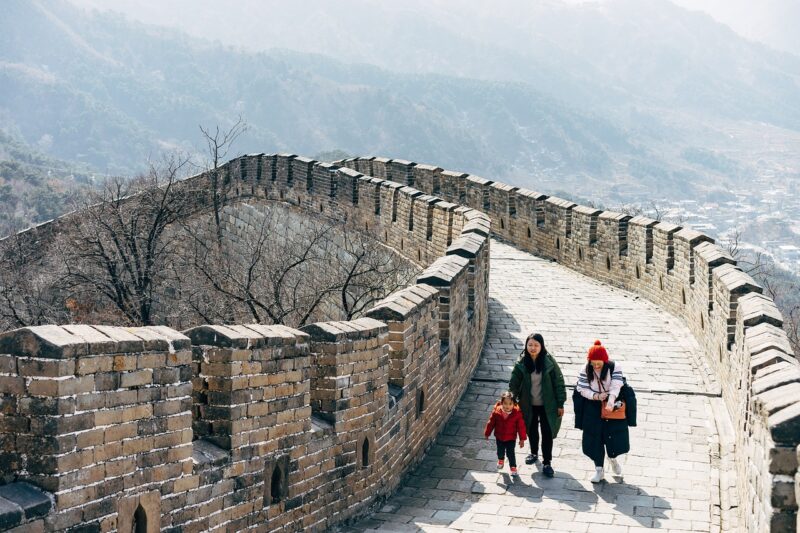
The Great Wall of China, a marvel of ancient engineering, stretches over 13,000 miles across the northern borders of the country. This awe-inspiring structure, built without the benefit of modern technology and tools, has stood the test of time, bearing witness to the ingenuity and determination of the people who constructed it. In this article, we delve into the methods and techniques used to build this monumental feat, exploring the historical context and the sheer scale of this endeavor.
1. The Historical Context of the Great Wall
The Great Wall was not the result of a single emperor’s vision, but rather a series of walls and fortifications built over several dynasties. The earliest sections date back to the 7th century BC during the Warring States Period, with significant contributions made by the Qin Dynasty (221-206 BC) and the Ming Dynasty (1368-1644 AD).
The need for the Great Wall arose from the desire to protect the Chinese states and empires from invasions by nomadic tribes from the north. It served as a physical barrier, a psychological deterrent, and a symbol of national strength. The wall also played a role in controlling immigration and emigration, facilitating trade along the Silk Road, and allowing for the efficient mobilization of troops in times of conflict.
2. Planning and Strategy: A Well-Thought-Out Design
Building the Great Wall required meticulous planning and strategic thinking. Before construction began, officials undertook surveys of the terrain to determine the most effective paths. The builders considered several factors that influenced the wall’s design:
- Topography: The wall often followed the contours of the landscape, utilizing natural features like mountains and rivers as part of its defense strategy. This not only saved resources but also provided a natural barrier against invaders.
- Material Availability: Builders used locally available materials, such as earth, wood, bricks, and stones, which reduced transportation costs and time. In the mountainous areas, stones were the primary building material, while in the plains, earth and bricks dominated.
- Local Craftsmanship: Skilled laborers and craftsmen were essential to the construction process. Builders were often sourced from nearby villages, where families passed down techniques and knowledge through generations.
This strategic planning was crucial for the successful construction of the Great Wall, as it allowed builders to maximize efficiency while minimizing costs and labor.
3. The Construction Techniques: Building Without Machinery
Constructing the Great Wall of China involved a combination of manual labor, ingenious techniques, and community involvement. Here’s a look at some of the primary methods employed:
3.1 Earth Walls
In many parts of the wall, particularly in the earlier constructions, workers built earth walls by stacking layers of packed earth. They used wooden frames called “formwork” to keep the earth in place while it was compressed.
1. **Layering Technique:** The preferred method involved layering the earth and compacting it with tools like wooden mallets or hammers. This method created durability and resistance to erosion.
2. **Natural Resources:** Where clay was abundant, builders used it to create mud bricks, which were stronger and more durable than earth alone.
3.2 Stone Wall Construction
The later Ming Dynasty sections primarily utilized stone, as it offered greater stability and strength against weather and attacks:
1. **Quarrying:** Workers quarried stone from local hillsides. They transported the stones using simple wooden sleds and manpower.
2. **Mortar Binding:** To hold the stones in place, they utilized a mix of lime, water, and sand as a binding agent, allowing the stones to adhere strongly to each other.
3. **Dry Stone Techniques:** In areas lacking mortar, laborers would stack stones carefully by selecting them for fit, reducing the need for additional bonding materials.
3.3 Organizational Labor
The construction project required a significant workforce, which was organized both by central authority and local communities:
1. **Conscription and Labor Taxes:** Many builders were conscripted laborers, with the government taxing local populations to provide workers for the project.
2. **Community Involvement:** Local communities were often involved in the process, contributing their labor as part of a shared national duty to protect their land from invaders.
3. **Military Supervision:** Troops were stationed along the wall, both for protection and to oversee the laborers, ensuring their efforts were effective and efficient.
4. Challenges Encountered During Construction
The construction of the Great Wall was steadfast but fraught with challenges:
1. **Natural Elements:** Builders faced harsh weather conditions, including extreme heat in summer and blistering cold in winter, complicating the building process and delaying progress.
2. **Terrain Difficulties:** The rocky terrain in mountainous regions posed significant challenges, often requiring innovative engineering solutions to ensure the wall’s stability.
3. **Labor Shortages:** The massive effort required meant that at times there were labor shortages, leading to delays and compromised quality in construction.
4. **Funding & Resource Allocation:** As the wall expanded over the centuries, securing funds and resources for the project was an ongoing struggle, particularly during periods of economic hardship.
5. The Legacy of the Great Wall
Despite the challenges faced during construction, the Great Wall of China remains one of the most significant architectural feats in human history. Its legacy can be traced through:
1. **Cultural Symbolism:** The Great Wall symbolizes China’s strength and resilience, emphasizing the determination of its people to protect their homeland.
2. **Tourism and Education:** Today, millions visit the Great Wall, inspiring awe and curiosity about Chinese history, engineering, and culture.
3. **UNESCO World Heritage Site:** Designated a UNESCO World Heritage Site in 1987, the Great Wall is recognized globally for its historical and cultural value.
4. **Modern Engineering Inspirations:** The techniques and collaboration found in its construction continue to inspire modern engineers and architects worldwide.
Conclusion
The Great Wall of China is not merely a physical barrier; it is a testament to human ingenuity, perseverance, and the collective effort of countless builders across generations. Its construction without modern tools showcases the remarkable skills and dedication of its creators. By understanding how this iconic structure came to be, we gain invaluable insight into not only ancient Chinese culture but also the universal themes of tenacity and collaboration inherent in monumental achievements.
Whether standing amidst its grandeur or contemplating its history, one cannot help but be inspired by the Great Wall of China—a remarkable feat achieved without the conveniences of the modern world.







